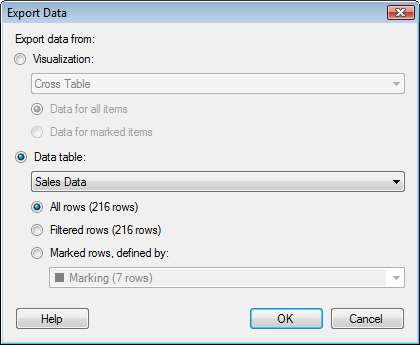
Tip: Use the Export data from Visualization option when you want to export from in-database data tables. See Working With In-Database Data for more information.
Note: For all visualizations other than tables, cross tables and summary tables you need to mark the items of interest to be able to export from the visualization.
To reach the Export Data dialog:
Select File > Export > Data to File....

Option |
Description |
Export
data from |
Allows you to select whether to export data based on a visualization or on a data table. |
Visualization |
Select this option to export data based on one of the visualizations in the active page, including the Details-on-Demand (if visible). Note: Data from a visualization can only be exported to an Excel file if the visualization is a table. You can export the data to a text file, to an Excel file, to a TIBCO Spotfire Text Data Format file (*.stdf) or to a TIBCO Spotfire Binary Data Format file (*.sbdf). See below for more information. |
Data
for all items |
Only available for tables, cross tables and summary tables. Exports all data in the selected visualization, the way it looks right now. This means that only the data remaining after the current filtering will be exported. |
Data
for marked items |
Exports data for the marked items in the selected visualization. Note that all marked rows will be exported, even if they are filtered out. |
Data
table |
Select this option to export data based on one of the data tables in the document. You can export the data to a text file, to an Excel file, to a TIBCO Spotfire Text Data Format file (*.stdf) or to a TIBCO Spotfire Binary Data Format file (*.sbdf). See below for more information. |
All
rows |
Exports all rows available in the entire data table, regardless of filtering. |
Filtered
rows |
Exports the rows remaining after the current filtering (using the filtering scheme on the active page) only. |
Marked
rows, defined by |
Exports the rows marked in the visualizations (using the specified marking) only, regardless of filtering. |
The TIBCO Spotfire Binary Data Format stores the data and metadata from your analysis in binary form. It can be used to greatly increase the performance when working with linked data in TIBCO Spotfire.
The TIBCO Spotfire Text Data Format also includes metadata. For example, the data types of the columns are saved, so you do not need to specify any import settings when opening files of this data format in TIBCO Spotfire. If you select the TIBCO Spotfire Text Data Format (*.txt) you will be able to open the file in older versions of TIBCO Spotfire (before 3.1) and in TIBCO Spotfire DecisionSite, but you will not get all functionality of the Spotfire Text Data Format.
See also:
Saving an Analysis File in the Library